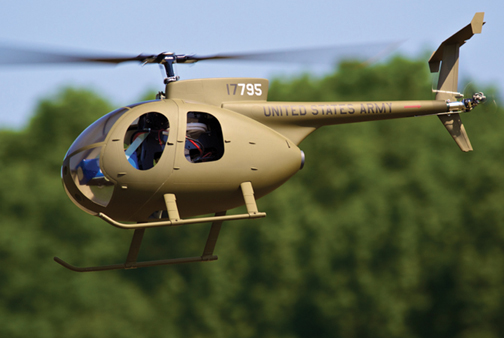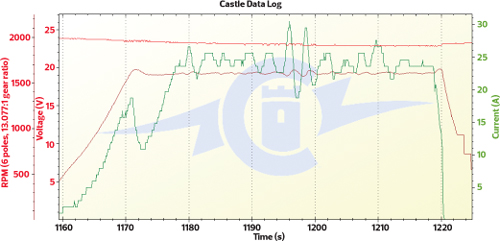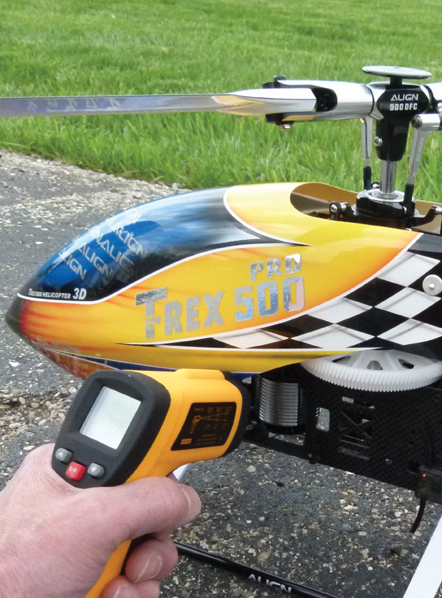
High-performance helis require systematic maintenance to ensure safe and reliable operation. Datalogging and non-invasive temperature checks can head off problems before they cause a crash. (Photo courtesy of John Kauk)
Data-logging and baselining

The data-logging capability built into speed controllers like Castle Creations’ Ice line or afforded by add-on units like Eagle Tree Systems’ eLogger allow you to create a baseline “thumbprint” for your helicopter. Periodically, you can compare the latest data with the baseline to look for an unexplained rise in current.
Data-logging and baselining
Clint surprised me right off the bat by steering the conversation away from the expected path of periodic teardowns, checking individual bearings, and inspecting parts for wear. Instead he explained that he takes advantage of the detailed data-logging capability built into Castle Creations speed controls. By establishing a baseline for each new heli, he can periodically check the data logs and look for suspicious increases in current. A baseline flight might consist of hovering, normal forward flight, and then heavy 3D acro to subject the drivetrain to heavy positive and negative collective inputs. This then becomes the “fingerprint,” for that particular heli.

A handheld laser infrared thermometer allows you to check the motor and major bearings after a flight. As with the data-logging baseline, you want to look for significant changes in temperature. Be sure and check temps immediately after a flight, before a bad bearing has a chance to cool.
Laser IR thermometers
The other bulwark of Clint’s approach to preventive maintenance is a laser infrared thermometer. These affordable but precise instruments allow you to check over the mechanics and look for hotspots that indicate a roached bearing, poor lubrication, or any other problem before it becomes a catastrophic failure. Here again, Clint recommends recording the figures on a newly built or overhauled heli to establish a baseline. All major bearings and the motor temperature are checked. Measuring motor temperature can be awkward on some heli designs, but you should be able to check the tip of the output shaft (good indicator of core temperature) the case and the endbell. You might also move the pinion away from the main gear so that you can check that the unloaded motor runs smoothly and quietly.
How do you know if a bearing is failing? There are no hard and fast rules, which is why the baseline figures are important. Generally, if you see a main shaft bearing that’s 150°F after a flight, alarm bells should be going off in your head!
Putting it to work
With your baseline figures established, you can now fly your heli with a clear conscience. Every couple of dozen flights, you can download the data logs and check to see that the current is in line with the baseline profile for that heli. If you suddenly see an increase in current, you then need to check the bearings and motor with your infrared thermometer to look for problems. An unexplained rise in current means a rise in friction, so keep looking until you find the problem.
Remembering the basics
Checking flight current and bearing temperatures can go a long way toward heading off issues before they become serious problems, but these tricks don’t take the place of regular visual inspection. Worn control links, loose screws, and worn-out head dampers won’t show up in the data logs, and won’t get hot, but they can still cost you degraded performance and perhaps a painful and avoidable crash. Another benefit of flybarless heads is that inspection and maintenance are so much simpler, but you still have to inspect all linkages. Finally, don’t forget the servos: modern digital servos are mechanical marvels, but they don’t last forever. Check the servos periodically to make sure they’re running smoothly, centering repeatedly, and showing minimal gear lash.
Electric helis are wonderfully reliable, but don’t let this reliability lull you into the trap of forgetting proper maintenance. Your heli will take care of you if you take care of it.
























another good area to do a closer inspection is belts/ pulleys. Take the belt OFF of the pulley and inspect the teeth for wear.. (Ask me how I know this?) sometimes the belt will look fine, but the pulley may have worn to the point of slipping under hard load.